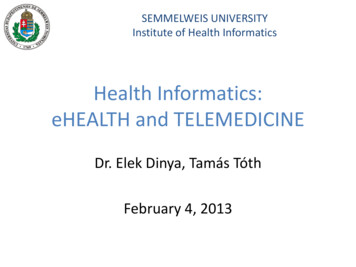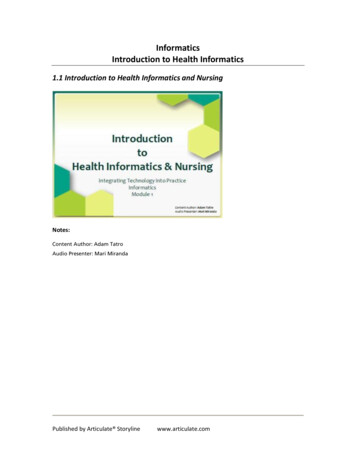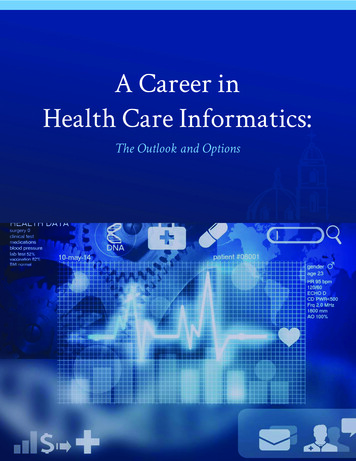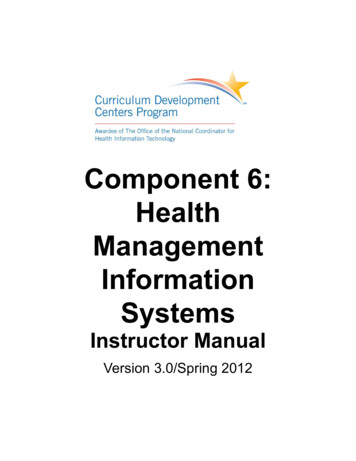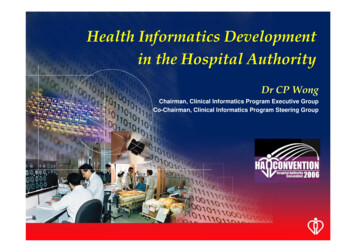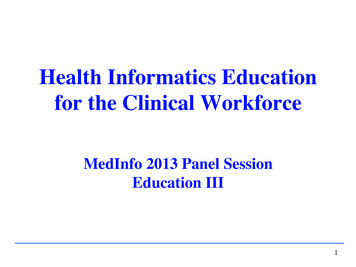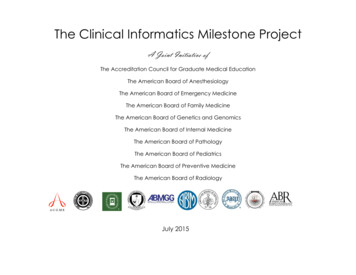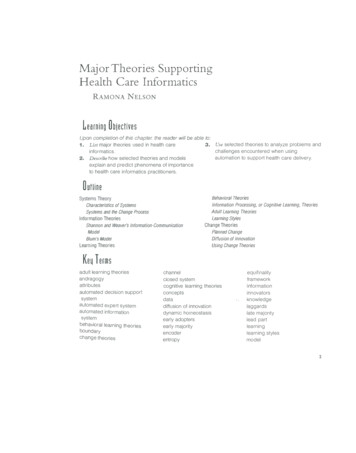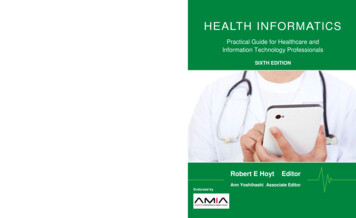
Transcription
Practical Guide for Healthcare and Information Technology ProfessionalsSIXTH EDITIONHealth Informatics focuses on the application of information technology (IT) to the field of medicine to improveHealth Informaticsfocuses ondelivery,the applicationtechnology(IT) in healthcareto improveindividualandpopulation healthcareeducationofandinformationresearch. Ourgoal is to stimulateand educate healthcareanindividual .The Thisgoalfifthof thetextbookis ut the keytopics educationin this rapidlyeditionreflectscurrent andeducate healthcareandlistedIT professionalsand studentsaboutthe keykeytopicsin thisfield. references.The sixthknowledgein the topicsbelow and eschangingand extensiveedition hasreflect thebook.changes in technology, policies and innovations that have occurred recently. It isAvailableas abeenhard updatedcopy andtoelectronicavailable as a paperback and an eBook.Textbookfeaturesin each chapter:1.Overviewof HealthInformatics14. Search Engines2. HealthcareInformation, and15. Evidence-Based Medicine and LearningData,objectivesKnowledgeClinicalPractice Guidelines Case studies: Real world examples from the United States and othercountries Recommended reading Future trends Key ManagementpointsPracticeSystems ConclusionsHealthInformation Exchange References3. Electronic Health Records4.5.6. Data StandardsFree Online Resources available on the textbook companion16. Disease Management andDisease Registries17. Quality Improvement Strategies18. Patient Safety and HealthTechnology The websitewebsite Informationwww.informaticseducation.orgSIXTH EDITIONfeaturesmore informationthe textbook, a resource center for students, a Health Informatics RSS news feed and an7.Architecturesof aboutInformationPrescribinginformaticsblog. The resource site has articles, web links and videos for19.eachElectronicchapter.Systems20. Telemedicine8. Health Information PrivacyPictureArchivingandhe established itsRobert Hoyt is the Director of the Medical Informatics Program at the21.Universityof WestFlorida where9. Health Information SecurityCommunicationonline Medical Informatics Certificate Program in 2004. He has practiced internalmedicine for over Systems35 years both in privatepracticeand themilitary. He useshis clinical and medical research experience and an evidence-based medicine approach10.HealthInformaticsEthicsto critically analyze health information technology (HIT). He has been a22.strongBioinformaticsadvocate of Health Informatics, believing that11.ConsumerHealthInformaticsinformation technology could help to improve patient care, continuity, efficiency,reportingand medicalresearch23. PublicHealthInformatics12. Mobile Technology24. e-Research13. Online Medical ResourcesHEA LTH INFORM ATICSHEALTH INFORMATICSHEA LTH INFORM ATICSPractical Guide for Healthcare andPractical Guide for Healthcare andInformation Technology ProfessionalsInformation Technology ProfessionalsSixth EditionSIXTH EDITIONRobertEEHoytHoyt EditorRobertEditorAnn Yoshihashi Associate EditorAnnYoshihashi Associate EditorEndorsed by
Health InformaticsPractical Guide for Healthcare andInformation Technology ProfessionalsSixth EditionROBERT E. HOYT MD FACPEditorANN K. YOSHIHASHI MD FACEAssociate Editor
Health InformaticsPractical Guide for Healthcare and Information Technology ProfessionalSixth EditionCopyright January 2014 by Informatics EducationFirst Edition: June 2007Second Edition: August 2008Third Edition: November 2009Fourth Edition: September 2010Fifth Edition: January 2012All rights reserved. No part of this book may be reproduced or transmitted in any form, by any means,electronic or mechanical, including photocopying, recording, or by any information storage and retrievalsystem, without written permission from the publisher, except for inclusion of brief excerpts in connectionwith reviews or scholarly analysis.Ebook ISBN 978-0-9887529-2-4(Paperback ISBN 978-1-304-79110-8 )DisclaimerEvery effort has been made to make this book as accurate as possible but no warranty is implied. Theinformation provided is on an “as is” basis. The authors and the publisher shall have neither liability norresponsibility to any person or entity with respect to any loss or damages arising from the informationcontained in this book. The views expressed in this book are those of the author and do not necessarilyreflect the official policy or position of the University of West Florida.Additional ResourcesVisit the textbook companion website at http://informaticseducation.org/
iEditorsRobert E. Hoyt MD, FACPDirector Medical InformaticsSchool of Allied Health and Life SciencesUniversity of West FloridaPensacola, FLAssistant Professor of MedicineAdjunct Assistant Professor of Family MedicineThe Uniformed Services University of the Health SciencesBethesda, MDAnn K. Yoshihashi MD, FACEGuest Lecturer, School of Allied Health and Life SciencesMedical InformaticsUniversity of West FloridaPensacola, FL
iiContributorsKenneth G. Adler MD, MMMMedical Director of Information TechnologyArizona Community PhysiciansTucson, AZElmer V. Bernstam MD, MSEProfessor of Biomedical Informatics and Internal MedicineAssociate Dean for ResearchSchool of Biomedical Informatics and Medical SchoolThe University of Texas Health Science CenterHouston, TXHarry B. Burke MD, PhDAssociate Professor, Biomedical InformaticsUniformed Services University of the Health SciencesBethesda, MDTrevor Cohen MD, MBChB, PhDAssociate Professor of Biomedical InformaticsSchool of Biomedical InformaticsThe University of Texas Health Science CenterHouston, TXRobert W. CruzSenior Director, Product R&DComputer Programs and Systems, IncMobile, ALLaJuana Ehlers, MEd, RT(R)(M)Assistant Professor, Radiologic SciencesColorado Mesa UniversityGrand Junction, COReynald Fleury, MSC, MBA, MPHHead of Healthcare InnovationIdea CoutureToronto, ONM. Chris Gibbons MD, MPHAssociate Director, Johns Hopkins Urban Health InstituteAssistant Professor of Medicine, Public Health and Health InformaticsJohns Hopkins Medical InstitutionsBaltimore, MD
Contributors iiiJohn Grizzard MD,Associate Professor, RadiologyDirector, Non-Invasive Cardiovascular ImagingVirginia Commonwealth UniversityRichmond, VAWilliam Hersh MD, FACP, FACMIProfessor and Chair, Department of Medical Informatics & ClinicalEpidemiologyOregon Health & Science UniversityPortland, ORBrent Hutfless MS, CISSP, GSLCIT DirectorAustal USAMobile, ALTodd Johnson PhDProfessor, School of Biomedical InformaticsUniversity of Texas Health Science CenterHouston, TXKen Masters PhDAssistant Professor of Medical InformaticsMedical Education UnitCollege of Medicine & Health SciencesSultan Qaboos UniversitySultanate of OmanEditor in Chief, The Internet Journal of Medical EducationJustice Mbizo Dr PHAssistant Professor, Masters of Public Health ProgramSchool of Allied Health and Life SciencesUniversity of West FloridaPensacola, FLIndra Neil Sarkar, PhD, MLISAssistant Professor, Departments of Microbiology & Molecular Geneticsand Computer ScienceDirector of Biomedical InformaticsUniversity of VermontBurlington, VTJohn Sharp MSSA, PMP, FHIMSSManager, Research InformaticsQuantitative Health SciencesCleveland ClinicCleveland, OH
iv ContributorsCaroline E. Thompson MSHealth Sciences LibrarianUniversity of West FloridaPensacola, FLBrandy G. Ziesemer, RHIA, CCSHealth Information Manager and Associate ProfessorLake-Sumter State CollegeLeesburg, FL
vPreface to the Sixth EditionHealth Informatics is an information science thatis concerned with the management of healthcaredata and information using a variety oftechnologies. As a result of exploding technologiesand expansive healthcare data, in addition tosupport from US Federal Government programs,there is tremendous interest in this relatively newfield.In order to keep up with the rapid pace ofdevelopments in Health Informatics, this is oursixth edition since publishing the originaltextbook in 2007.The sixth edition has been endorsed by the AMIAfor continuing education of informaticists. Manyof our textbook authors are AMIA members andmajor contributors to the field of HealthInformatics.In this edition we have re-written all chapters toreflect the rapid changes in the field. We havefocused heavily on Meaningful Use, the yard stickfor electronic health record implementation in theUnited States.We added a new chapter on Healthcare DataAnalytics, given the interest in managinghealthcare data, to include “big data.” Weconsolidated the chapter on electronic prescribingand practice management systems into thechapter on electronic health records. The PACSchapter was changed to Medical ImagingInformatics and we added an academic radiologistas co-author.Readers can expect similar organization to eachchapter. All chapters start with learning objectivesand an introduction and end with recommendedreading, key points, future trends and aconclusion. In addition, most chapters includecase studies to highlight interesting national andinternational initiatives. We have made everyattempt to provide the most up-to-dateinformation about health informatics recentinformation and the most interesting concepts.We are dedicated to presenting the issues fairlyand objectively and have avoided the hype sometimes associated with new technologies. Thistextbook should give readers, especially those newtohealthcareortechnology,abetterunderstanding of this burgeoning field. It is also aresource/reference for people in the field,reviewing for clinical informatics board and forboth graduate and undergraduate courses.Approximately 1900 medical literature referencesand web links are included in this book that helpdirect readers to additional information.While we are vendor agnostic we are not opposedto presenting interesting hardware and software,including open source, we think will be of interestto our readers. One of the goals of this book is topromote and disseminate innovations that mighthelp healthcare workers as well as technologydevelopers. The fact that we mention specifichardware or software or web-based applicationsdoes not mean we endorse the vendor; instead, itis our attempt to highlight an interesting conceptor innovation that might lead others in a newdirection.A Resource Center was created for each bookchapter that contains articles, web links andvideos for students and instructors located atwww.informaticseducation.org .We appreciate feedback regarding how to makethis book as user friendly, accurate, up-to-dateand educational as possible. Please note that bookproceeds will be donated to support theadvancement of health informatics education.Robert E. Hoyt MD FACPAnn K. Yoshihashi MD FACEAcknowledgements: We would like to acknowledge Alison Fields for her invaluable support inperforming literature searches and proofreading that were critical in updating the sixth edition. Secondwe are indebted to Jo Ann Clay for transforming the format of the book and contributing to the overalllook and feel of the textbook.
Table of ContentsCONTRIBUTORS . .IIPREFACE TO SIXTH EDITION VCHAPTER 1OVERVIEW OF HEALTH INFORMATICS .1LEARNING OBJECTIVES 1INTRODUCTION .1INFORMATICS DEFINITIONS . . . .4BACKGROUND .5HISTORICAL HIGHLIGHTS. 9KEY PLAYERS IN HEALTH INFORMATION TECHNOLOGY . 11ORGANIZATIONS INVOLVED WITH HIT .13BARRIERS TO HIT ADOPTION 21HEALTH INFORMATICS PROGRAMS, ORGANIZATIONS AND CAREERS .24HEALTH INFORMATICS RESOURCES .28FUTURE TRENDS . 31CONCLUSION . 32REFERENCES .32CHAPTER 2HEALTHCARE DATA, INFORMATION AND KNOWLEDGE . 39LEARNING OBJECTIVES 39INTRODUCTION .39DEFINITIONS AND CONCEPTS . 42CONVERTING DATA TO INFORMATION TO KNOWLEDGE 44CLINICAL DATA WAREHOUSES (CDWS) 46WHAT MAKES INFORMATICS DIFFICULT?. 51WHY HEALTH IT FAILS SOMETIMES . 54FUTURE TRENDS 56CONCLUSION .58REFERENCES .58CHAPTER 3HEALTHCARE DATA ANALYTICS . . 62LEARNING OBJECTIVES 62INTRODUCTION .62TERMINOLOGY OF ANALYTICS . .62CHALLENGES TO DATA ANALYTICS . .64RESEARCH AND APPLICATION OF ANALYTICS. .65ROLE OF INFORMATICIANS IN ANALYTICS 67RECOMMENDED READING 68FUTURE TRENDS 68CONCLUSION 69REFERENCES .70CHAPTER 4ELECTRONIC HEALTH RECORDS . 76LEARNING OBJECTIVES . 76INTRODUCTION .76NEED FOR ELECTRONIC HEALTH RECORDS . 77INSTITUTE OF MEDICINE’S VISION FOR EHRS . 82ELECTRONIC HEALTH RECORD KEY COMPONENTS. 83COMPUTERIZED PHYSICIAN ORDER ENTRY (CPOE) . 84CLINICAL DECISION SUPPORT SYSTEMS (CDSS) . 86
Table of Contents viiELECTRONIC PRESCRIBING. . 89PRACTICE MANAGEMENT INTEGRATION . . 91ELECTRONIC HEALTH RECORD ADOPTION . 95ELECTRONIC HEALTH RECORD AND MEANINGFUL USE CHALLENGES . 97THE HITECH ACT AND EHR REIMBURSEMENT . 102ELECTRONIC HEALTH RECORD EXAMPLES. 106LOGICAL STEPS TO SELECTING AND IMPLEMENTING AN EHR . . 109RECOMMENDED READING . . 116FUTURE TRENDS .117CONCLUSION . .118APPENDIX 4.1 STAGE 1 AND 2 MEANINGFUL USE CORE OBJECTIVES AND MEASURES 119APPENDIX 4.2 PROPOSED STAGE 3 MEANINGFUL USE GOALS . 122REFERENCES. 123CHAPTER 5HEALTH INFORMATION EXCHANGE . 134LEARNING OBJECTIVES . 134INTRODUCTION . 134HISTORY OF THE NATIONWIDE HEALTH INFORMATION NETWORK . 136HITECH ACT IMPACT . 143HEALTH INFORMATION ORGANIZATIONS . 145HEALTH INFORMATION ORGANIZATION EXAMPLES . 150STATEWIDE HIE COOPERATIVE AGREEMENT PROGRAM . 153CURRENT STATUS OF US HEALTH INFORMATION EXCHANGE . 154HEALTH INFORMATION EXCHANGE CONCERNS . 155HEALTH INFORMATION ORGANIZATION RESOURCES . 155RECOMMENDED READING . . 157FUTURE TRENDS . 157CONCLUSION . 158REFERENCES. 159CHAPTER 6DATA STANDARDS AND MEDICAL CODING . 163LEARNING OBJECTIVES . 163INTRODUCTION . 163CONTENT STANDARDS . 163TERMINOLOGY STANDARDS . 167TRANSPORT STANDARDS . 170MEDICAL CODING AND REIMBURSEMENT . 171FUTURE TRENDS . 176CONCLUSION . 176REFERENCES. 176CHAPTER 7ARCHITECTURES OF INFORMATION SYSTEMS .179LEARNING OBJECTIVES . 179INTRODUCTION . 179THE INTERNET AND WORLD WIDE WEB . 179WEB SERVICES . . .181NETWORKS .184FUTURE TRENDS .190CONCLUSION . 191REFERENCES. 191CHAPTER 8HEALTH INFORMATION PRIVACY AND SECURITY . 193LEARNING OBJECTIVES . 193INTRODUCTION . 193HIPAA REVIEW . . .194BASIC SECURITY PRINCIPLES . .197HIPAA, MEANINGFUL USE, AND THE HITECH ACT . 199
viii Table of ContentsAUTHENTICATION AND IDENTITY MANAGEMENT . 200DATA SECURITY IN THE CLOUD AND CLIENT/SERVER SOLUTIONS . 203STANDARDS, COMPLIANCE AND LAW . . .205SECURITY BREACHES AND ATTACKS . .205MEDICAL PRIVACY AND SECURITY STORIES IN THE NEWS . . 208RECOMMENDED READING . . 209FUTURE TRENDS .210CONCLUSION . 211REFERENCES .212CHAPTER 9 HEALTH INFORMATICS ETHICS . 217LEARNING OBJECTIVES . 217INTRODUCTION . 217THE ROAD FROM NUREMBERG . . 217INFORMATICS ETHICS .219INTERNATIONAL CONSIDERATIONS: ETHICS, LAWS AND CULTURE.221CODES OF INDIVIDUAL COUNTRIES . .223PERTINENT ETHICAL PRINCIPLES . .224DIFFICULTIES APPLYING MEDICAL ETHICS IN THE DIGITAL WORLD . 225TRANSFERRING ETHICAL RESPONSIBILITY . 227ELECTRONIC COMMUNICATION WITH PATENTS AND CAREGIVERS . 228PRACTICAL STEPS . 229HEALTH INFORMATICS ETHICS AND MEDICAL STUDENTS . 232FUTURE TRENDS . 234CONCLUSION . 235REFERENCES . 236CHAPTER 10 CONSUMER HEALTH INFORMATICS .242LEARNING OBJECTIVES . 242INTRODUCTION . 242THE ORIGINS OF CONSUMER HEALTH INFORMATICS. 243CLASSIFICATION OF HEALTH INFORMATICS APPLICATIONS. 245HEALTH EDUCATION & INFORMATION APPLICATIONS . 247HOME TELEMEDICINE DEVICES . 249PATIENT WEB PORTALS . 250PERSONAL HEALTH RECORDS (PHRS) . 252ELECTRONIC PATIENT TO PHYSICIAN COMMUNICATION . 253SOCIAL MEDIA . .256RECOMMENDED READING . .257BARRIERS TO CHI ADOPTION . 258FUTURE TRENDS . 259CONCLUSION . 260REFERENCES .261CHAPTER 11 MOBILE TECHNOLOGY 265LEARNING OBJECTIVES . 265INTRODUCTION . 265HISTORY OF MOBILE TECHNOLOGY . 266MOBILE HEALTH (MHEALTH). 268MOBILE TECHNOLOGY AND PATIENTS . 269MOBILE TECHNOLOGY AND CLINICIANS . 272MOBILE TECHNOLOGY TO TRACK HEALTH HABITS . . .276MOBILE TELEMEDICINE PROJECTS .277RECOMMENDED READING . .277MOBILE TECHNOLOGY RESOURCES . 279MOBILE TECHNOLOGY CHALLENGES . 279FUTURE TRENDS . 280
Table of Contents ixCONCLUSION . 281REFERENCES. 281CHAPTER 12 ONLINE MEDICAL RESOURCES 285LEARNING OBJECTIVES . 285INTRODUCTION . 285SPONSORED MEDICAL WEB SITES .293SPONSORED AND NON-SPONSORED RESOURCES . 294GOVERNMENT MEDICAL WEB SITES . 294FREE MEDICAL WEB SITES .295FREE PATIENT EDUCATION SITES . .296SUBSCRIPTION (FEE-BASED) RESOURCES . 296EVIDENCE BASED SUBSCRIPTION PRODUCTS . .298RECOMMENDED READING READING . .299FUTURE TRENDS . 299CONCLUSION . 300REFERENCES. 300CHAPTER 13 MEDICAL INFORMATION RETRIEVAL . 304LEARNING OBJECTIVES . 304INTRODUCTION . 304GOOGLE. 305PUBMED SEARCH ENGINE. 306RECOMMENDED READING READING . .320FUTURE TRENDS . 320CONCLUSION .
Health Informatics ocuses on the applic ationof inform technology (IT) in healthcare o improve individual and population healthcare delivery , education and research. The goal of the textbook is to stimulate and educate healthcare and IT professionals and students about
